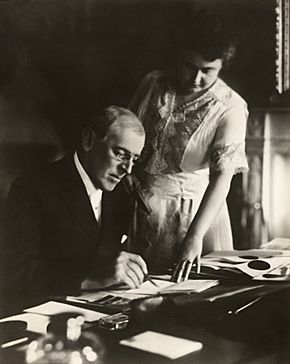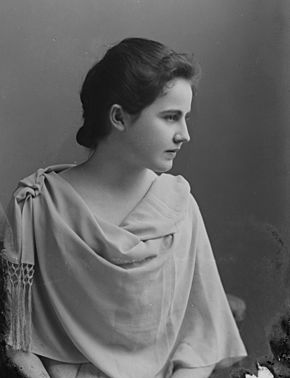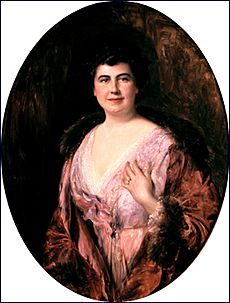Edith Wilson facts for kids
Quick facts for kids
Edith Wilson
|
|
|---|---|
 |
|
| First Lady of the United States | |
| In role December 18, 1915 – March 4, 1921 |
|
| President | Woodrow Wilson |
| Preceded by | Margaret Wilson (acting) |
| Succeeded by | Florence Harding |
| Personal details | |
| Born |
Edith Bolling
October 15, 1872 Wytheville, Virginia, U.S. |
| Died | December 28, 1961 (aged 89) Washington, D.C., U.S. |
| Resting place | Washington National Cathedral |
| Spouses |
Norman Galt
(m. 1896; died 1908) |
| Children | 1 |
| Signature | |
Edith Wilson (born Bolling, formerly Galt; October 15, 1872 – December 28, 1961) was the First Lady of the United States from 1915 to 1921. She was the second wife of President Woodrow Wilson. They married in December 1915, during his first term as president. Edith Wilson became very important in President Wilson's government after he had a serious stroke in October 1919. For the rest of his time as president, she helped manage the president's office. She decided which messages and important matters should be shown to the sick president. She later called this role a "stewardship," meaning she was taking care of things for him.
Contents
Early Life of Edith Bolling
Edith Bolling was born on October 15, 1872, in Wytheville, Virginia. Her parents were William Holcombe Bolling, a judge, and Sarah "Sallie" Spears. Her birthplace, the Bolling Home, is now a museum in Wytheville's Historic District.
Edith came from one of the oldest families in Virginia. Her family had lived in the Virginia Colony for many generations. Through her father, she was also a descendant of Pocahontas. Pocahontas was the daughter of Wahunsenacawh, a powerful leader of the Powhatan Confederacy.
Edith was the seventh of eleven children. Sadly, two of her siblings died when they were babies. Before the American Civil War, her family was part of the wealthy planter families in Virginia. After the war ended and slavery was abolished, Edith's father became a lawyer to support his family. He could not pay taxes on all his land, so the family moved to Wytheville. Most of his children, including Edith, were born there.
The Bolling home was always full of people. Edith grew up with her eight surviving brothers and sisters. Her grandmothers, aunts, and cousins also lived with them. Many women in her family had lost their husbands during the Civil War. The Bollings were proud of their Southern heritage. When Edith was young, she was taught about the "Lost Cause." This was a way many people in the South viewed the Civil War after it ended.
Edith's Education
Edith did not have much formal schooling. While her sisters went to local schools, Edith learned to read and write at home. Her grandmother, Anne Wiggington Bolling, taught her a lot. Her grandmother was sick and stayed in bed. Edith helped care for her, washing her clothes and turning her in bed.
In return, Grandmother Bolling taught Edith many things. She learned to read, write, and do basic math. She also learned a mix of French and English, and how to make dresses. Her grandmother also taught her to make quick decisions and have strong opinions. Edith showed these traits throughout her life. Her father read classic English books to the family. He also hired a tutor for Edith and sometimes took her on his travels. The Bolling family went to church regularly, and Edith was a lifelong Episcopalian.
When Edith was 15, her father sent her to Martha Washington College. This was a finishing school for girls in Abingdon, Virginia. Edith did not like it there. She found the school strict and the food bad. She left after only one semester. Two years later, she went to Powell's School for Girls in Richmond, Virginia. Edith later said this was the happiest time of her life. However, the school closed after a year. Her father then decided not to pay for more schooling for Edith. He chose to focus on educating her three brothers instead.
First Marriage to Norman Galt
While visiting her sister in Washington, D.C., Edith met Norman Galt (1864–1908). He was a well-known jeweler. They married on April 30, 1896. They lived in Washington, D.C., for 12 years. In 1903, Edith had a son, but he lived for only a few days. After this, she could not have more children. In January 1908, Norman Galt died suddenly at age 43. Edith hired someone to manage his business. She paid off his debts and used the money he left her to travel in Europe.
First Lady of the United States
Marriage to Woodrow Wilson
In March 1915, Edith Galt, who was now a widow, met U.S. President Woodrow Wilson. He had also recently lost his wife. They met at the White House through Helen Woodrow Bones, who was the president's cousin. Helen was the official White House hostess after Wilson's first wife, Ellen, died. President Wilson liked Edith right away and asked her to marry him soon after they met.
However, there were untrue rumors that Wilson had been unfaithful to his first wife with Edith. There was even gossip that they had caused the death of the first Mrs. Wilson. This made the couple very upset. President Wilson thought Edith should end their engagement because of the rumors. But Edith insisted they just wait to get married until after the official year of mourning for Ellen Wilson was over. Wilson married Edith Galt on December 18, 1915, at her home in Washington, D.C. About 40 guests attended the wedding.
Early Role as First Lady
As First Lady during World War I, Edith Bolling Wilson set an example for the country. She observed "gasless Sundays," "meatless Mondays," and "wheatless Wednesdays." This helped with the national rationing efforts. She also had sheep graze on the White House lawn instead of using people to mow it. The wool from the sheep was then sold to help the American Red Cross.
Edith Wilson was also the first First Lady to travel to Europe while her husband was president. She went with him twice, in 1918 and 1919. They visited troops and signed the Treaty of Versailles. Her presence among European royalty helped show America's growing power in the world. It also made the role of First Lady more important in international politics.
The war in Europe overshadowed the social duties of the First Lady. After the United States joined the war in 1917, these social events stopped. Edith Wilson focused on helping her husband stay healthy under great stress. She went with him to Europe when the Allied leaders discussed peace terms.
Increased Role After Husband's Stroke

After attending the Paris Peace Conference in 1919, Woodrow Wilson returned to the United States. He wanted the Senate to approve the peace treaty and the League of Nations. But in October, the president had a stroke. This left him very ill and partially paralyzed. The United States never approved the Treaty of Versailles or joined the League of Nations, which had been Wilson's idea. At that time, many Americans did not want to get involved in other countries' problems.
Edith Wilson and others close to the President kept the true extent of his illness a secret from the public. Edith also took over many of the president's daily duties. She did this from when he got sick until he left office, about a year and a half later. From October 1919 until March 4, 1921, Edith acted as a "shadow steward." She decided who could see the sick president and which messages were important enough for him.
Edith Wilson later wrote: "I looked at every paper sent from the different Secretaries or Senators. I tried to make them shorter and easier to understand for the President. I never made a single decision about public affairs myself. My only decision was what was important and what was not. And the very important decision of when to show things to my husband." Edith became the only way for the President to communicate with his Cabinet. She asked them to send her all important matters, notes, letters, questions, and requests.
Edith took her role very seriously. She even pushed for the removal of Secretary of State Robert Lansing. He had held Cabinet meetings without the President (or Edith) being there. She was given secret information and was trusted to encode and decode secret messages.
Later Years
After leaving the White House in March 1921, Edith and the former president moved to a home in Washington, D.C. She cared for him there until he died on February 3, 1924. In the years that followed, she led the Woman's National Democratic Club. She also published her memoir, a book about her life, in 1939.
On December 8, 1941, the day after Japan attacked Pearl Harbor, President Franklin D. Roosevelt asked Congress to declare war. He mentioned Wilson's declaration of war in 1917. Edith Wilson was there during Roosevelt's speech to Congress. She also attended Roosevelt's funeral in 1945. Later, she attended the inauguration of President John F. Kennedy in 1961.
Edith Wilson died on December 28, 1961, at age 89, from heart failure. She was supposed to be the special guest that day at the dedication of the Woodrow Wilson Bridge. This bridge crosses the Potomac River between Maryland and Virginia. It would have been her husband's 105th birthday. She was buried next to her husband at the Washington National Cathedral.
Legacy
Edith Wilson left her home to the National Trust for Historic Preservation. She wanted it to become a museum honoring her husband. The Woodrow Wilson House opened as a museum in 1964. Mrs. Wilson also gave President Wilson's papers to the Library of Congress in 1939. Later, in 1946, she donated his personal library.
The Edith Bolling Wilson Birthplace Foundation & Museum was started in Wytheville, Virginia, in 2008. This foundation has helped save the First Lady's birthplace and childhood home. The foundation's programs and exhibits aim to teach people about Mrs. Wilson. They honor her contributions to the country and the presidency. They also highlight her as an example for women. The Foundation shares Mrs. Wilson's journey "From Wytheville to The White House."
In 2015, an old bank building in Wytheville was named after the First Lady. It is now the Bolling Wilson Hotel. It serves people living in Wytheville and travelers.
Images for kids
See also
 In Spanish: Edith Wilson para niños
In Spanish: Edith Wilson para niños



